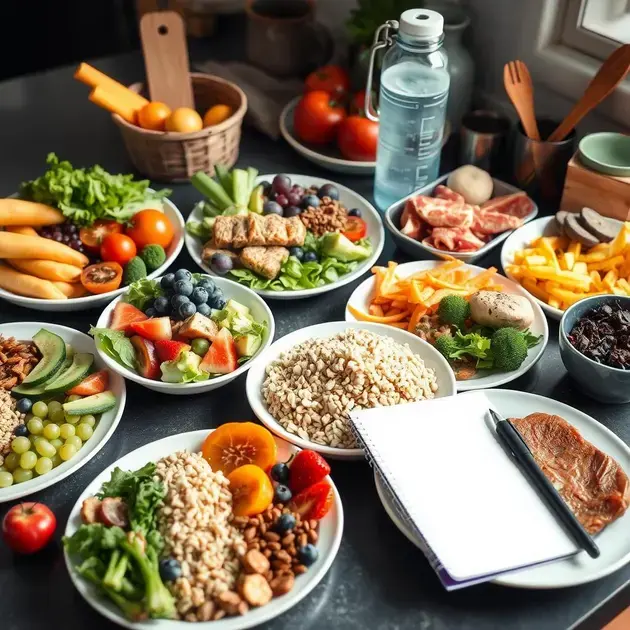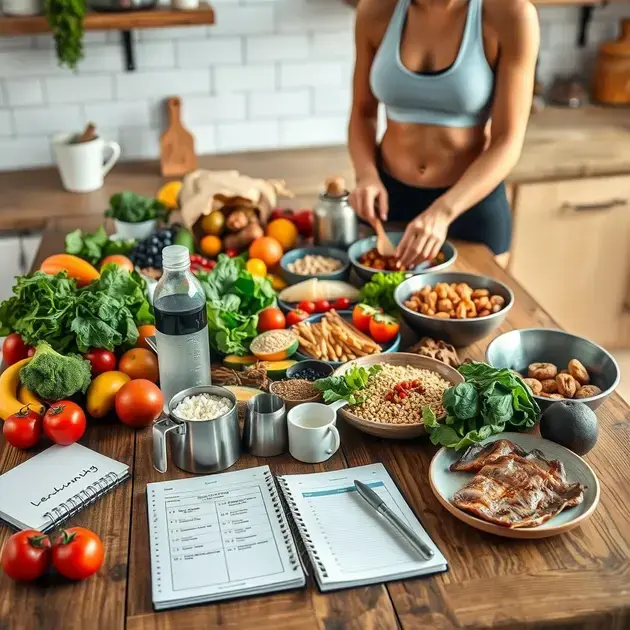Create A Game-Changing Weight Loss Meal Plan
Struggling to shed those extra pounds? Look no further! Discover the ultimate guide on crafting an effective weight loss meal plan that will transform your journey towards a healthier, fitter you. Let’s dive into easy-to-follow steps and expert tips to kickstart your weight loss goals.

Crafting Your Weight Loss Meal Plan Blueprint
Navigating Through Nutritional Essentials
When embarking on a weight loss journey, understanding and incorporating nutritional essentials is crucial for success. Here’s a step-by-step guide to help you navigate these essentials effectively:
1. Assess Your Caloric Needs:
The first step is determining your daily caloric requirements based on factors like age, gender, weight, and activity level. Tools like online calculators can help you establish this baseline.
2. Prioritize Whole Foods:
Focusing on whole, nutrient-dense foods such as fruits, vegetables, whole grains, lean proteins, and healthy fats ensures you get essential nutrients without excess calories. Create a grocery list centered around these items.
3. Balance Macronutrients:
Aim to include a balance of carbohydrates, proteins, and fats in your meals. Carbs provide energy, proteins support muscle growth and repair, and fats are essential for various bodily functions.
4. Stay Hydrated:
Water is often overlooked but crucial for metabolism and overall health. Aim to drink adequate water throughout the day, especially before meals to aid digestion.
5. Monitor Portion Sizes:
Understanding proper portion sizes is key. Use measuring cups, a food scale, or visual cues to ensure you’re not overeating. This practice can prevent excess calorie intake.
Maximizing Your Workout Results with Fuel-Efficient Meals
To optimize your exercise routine and achieve your fitness goals, it’s essential to fuel your body with the right nutrients. Here’s a detailed guide on maximizing your workout results through fuel-efficient meals:
1. Pre-Workout Fuel:
Prioritize carbohydrates and a moderate amount of protein before your workout to provide energy and support muscle function. Examples include a banana with almond butter or Greek yogurt with berries.
2. Post-Workout Recovery:
After exercise, focus on replenishing glycogen stores and supporting muscle recovery with a combination of carbs and protein. Opt for options like a protein smoothie with fruit or grilled chicken with sweet potatoes.
3. Hydration Is Key:
Proper hydration is crucial for optimal exercise performance and recovery. Drink water before, during, and after your workout to replace fluids lost through sweat.
4. Include Healthy Fats:
Don’t forget healthy fats like avocados, nuts, and olive oil in your post-workout meals. They provide essential nutrients and can aid in nutrient absorption and joint health.
5. Listen to Your Body:
Above all, listen to your body’s cues. Pay attention to how different foods make you feel before and after workouts. Adjust your pre and post-workout meals based on your energy levels and recovery.

Revamping Your Eating Habits for Effective Weight Loss Success
Embarking on a weight loss journey requires a holistic approach, starting with revamping your eating habits. To kickstart your weight loss plan meal, focus on incorporating nutrient-dense foods while cutting back on processed and high-calorie options. Opt for whole grains, lean proteins, fruits, and vegetables to create a balanced plate that supports your weight loss goals. Additionally, consider portion control as a key factor in managing caloric intake.
Cultivating mindful eating habits is crucial for sustainable weight loss. Chew your food slowly, savoring each bite, and listen to your body’s hunger and fullness cues. Avoid distractions such as screens while eating to better tune into your body’s signals. By making conscious food choices and being present during meals, you can support your weight loss efforts in the long run.
Experiment with diverse recipes and flavors to keep your weight loss plan meal exciting and satisfying. Incorporate herbs and spices for added taste without extra calories. Explore different cooking methods such as steaming, grilling, or baking to enhance the nutritional profile of your meals. Variety in your diet not only keeps boredom at bay but also ensures you get a wide range of nutrients.
Stay hydrated throughout the day, as thirst can sometimes be mistaken for hunger. Opt for water as your primary beverage and limit sugary drinks and alcohol, which can contribute empty calories. Prioritize whole foods over liquid calories to fuel your body with essential nutrients and support your weight loss journey.
Creating Balanced and Sustainable Meal Options for Your Weight Loss Journey
Building a repertoire of balanced and sustainable meal options is essential for maintaining a successful weight loss plan meal. Start by planning your meals in advance, focusing on incorporating a mix of macronutrients – proteins, carbohydrates, and healthy fats – to keep you full and energized. Include a variety of colors on your plate to ensure you’re getting a spectrum of vitamins and minerals.
Prepare meals in batches to save time and avoid impulse choices that may derail your weight loss progress. Make use of containers to portion out snacks and meals, making healthy options readily available. Opt for whole, unprocessed foods whenever possible, as they are typically lower in calories and higher in nutrients compared to processed alternatives.
Experiment with plant-based meals to add fiber and phytonutrients to your diet. Incorporate legumes, nuts, seeds, and whole grains for plant-based protein sources that also offer essential nutrients. Including vegetarian or vegan meals in your rotation can introduce variety and promote weight loss by emphasizing whole foods.
Don’t forget to indulge in moderation to maintain a balanced approach to your weight loss plan meal. Allow yourself occasional treats or higher-calorie meals, but practice portion control and mindful eating. By integrating a balance of nutrient-dense options with occasional indulgences, you can sustain your weight loss journey in the long term.
Implementing Strategic Meal Planning Strategies for Optimal Weight Loss Goals
Strategic meal planning plays a crucial role in achieving optimal weight loss goals. Start by setting specific and realistic targets for your meals, considering factors such as caloric intake, macronutrient balance, and meal timings. Create a weekly meal plan that aligns with your weight loss objectives, incorporating variety and flexibility to prevent monotony.
Utilize tools such as food journals or meal planning apps to track your food intake and monitor your progress. Keeping a record of what you eat can help you identify patterns, make adjustments as needed, and stay accountable to your weight loss plan meal. Aim for consistency in your eating schedule to regulate appetite and maintain steady energy levels throughout the day.
Consider incorporating intermittent fasting into your meal planning strategy to support weight loss. Experiment with different fasting windows, such as 16/8 or 18/6, to find a schedule that works best for your lifestyle and preferences. Fasting periods can help regulate hunger hormones, promote fat burning, and enhance metabolic efficiency.
Plan ahead for challenging situations, such as dining out or social gatherings, by researching menu options in advance and making mindful choices. Opt for grilled or steamed dishes, request dressings and sauces on the side, and prioritize vegetables and lean proteins. By strategizing for potential obstacles, you can navigate social settings while staying aligned with your weight loss goals.
Conclusion
Creating an effective weight loss meal plan is a journey that requires thoughtful planning and dedication. By assessing your caloric needs and prioritizing whole, nutrient-dense foods, you build a foundation for success. Balancing macronutrients, staying hydrated, and practicing portion control are essential elements that can help you make healthier choices along the way.
Incorporating strategic meal planning not only makes your food choices easier but also contributes to sustained weight loss. Experimenting with diverse recipes, integrating healthy fats, and staying mindful of your eating habits create a satisfying experience while ensuring you remain on track. Embrace the approach of variety and moderation, allowing yourself the occasional indulgence without derailing your progress.
Remember that this journey is personal, and listening to your body’s signals is crucial. By nurturing a positive relationship with food, you empower yourself to stay committed to your weight loss goals. With time, effort, and consistency, you can achieve your desired outcomes and enjoy a healthier, happier lifestyle.
